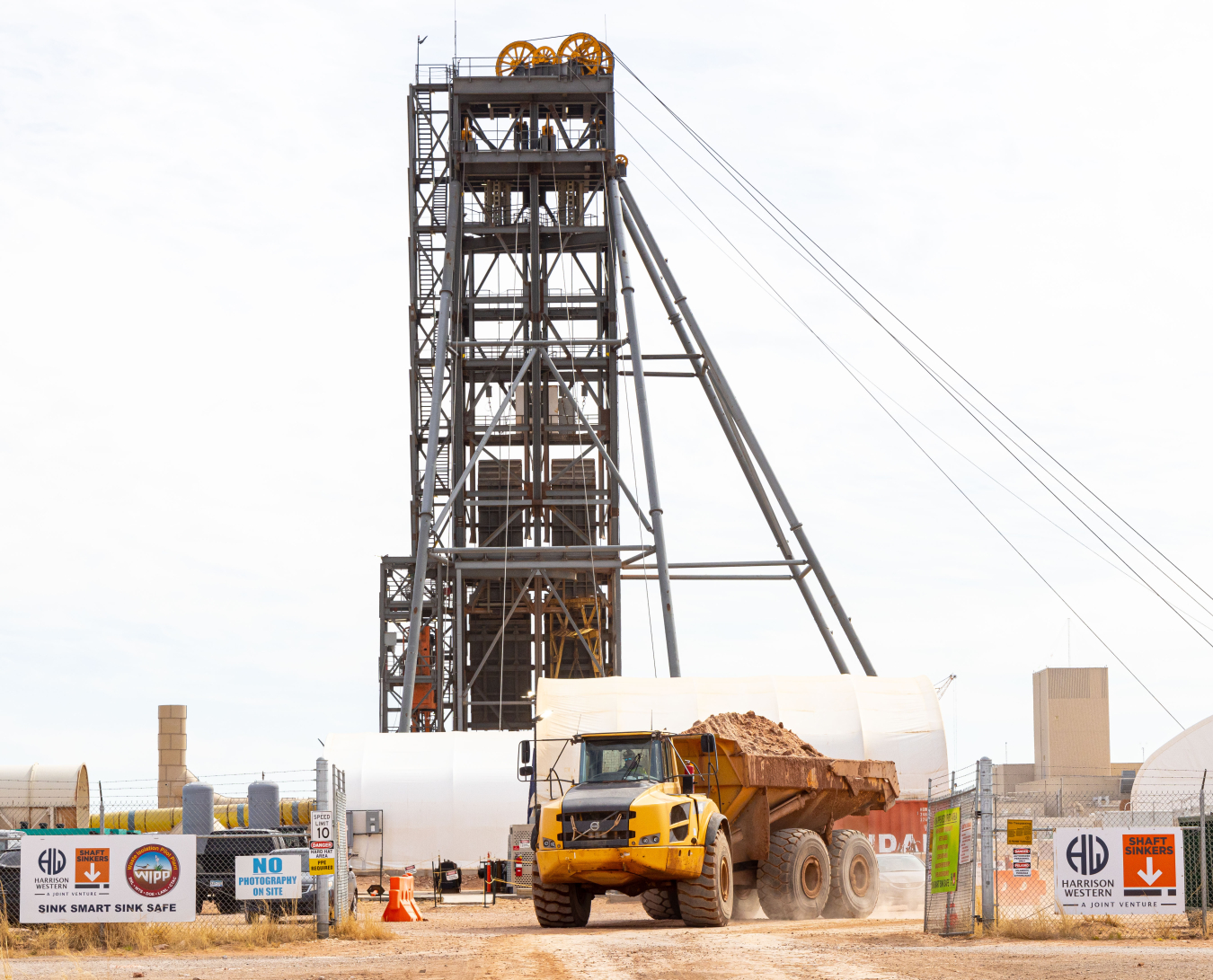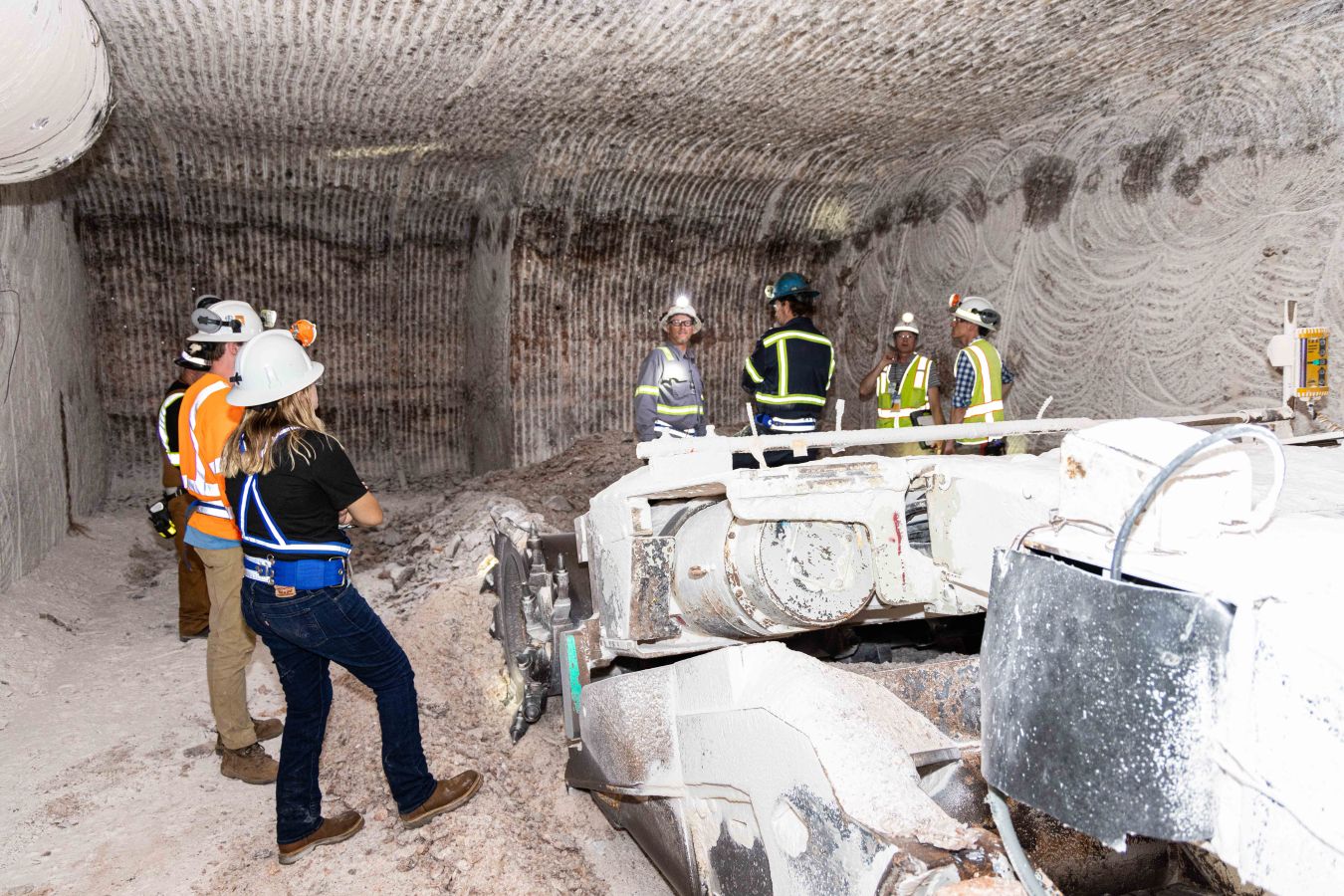Excavation crews recently attained a milestone in the construction of a new utility shaft at EM’s Waste Isolation Pilot Plant (WIPP).
Office of Environmental Management
July 11, 2023
A truck hauls excavated salt away from the Waste Isolation Pilot Plant's (WIPP) utility shaft project, marked by a large aboveground steel headframe. The shaft, key to WIPP’s new air ventilation project, has reached the depth necessary to allow horizontal tunneling work to begin on connecting the shaft to the WIPP underground repository complex. The repository is 2,150 feet below ground level.
Connection work to underground repository now begins
CARLSBAD, N.M. – Excavation crews recently attained a milestone in the construction of a new utility shaft at EM’s Waste Isolation Pilot Plant (WIPP).
They’ve reached an underground depth, known as station depth, that allows horizontal tunneling work to begin on connecting the shaft to the WIPP repository complex. The repository sits at 2,150 feet below ground level.
“This is a hugely significant step in increasing airflow in the WIPP underground,” said Mark Bollinger, manager of EM’s Carlsbad Field Office. “Congratulations to the crews, who have safely and compliantly worked around the clock to make continual progress on an important part of the new WIPP infrastructure.”
The utility shaft, WIPP’s largest at 26 feet in diameter when completed, will provide air to the Safety Significant Confinement Ventilation System (SSCVS), the largest containment ventilation system in the DOE complex. That system and the utility shaft are being built by Salado Isolation Mining Constructors (SIMCO), EM’s management and operations contractor at WIPP.
“This is a tremendous accomplishment for our WIPP workforce,” said Ken Harrawood, SIMCO president and program manager. “The new utility shaft is a key component of the SSCVS that, when online, will enhance WIPP’s capability to deliver the nation and New Mexico’s cleanup mission.”

Waste Isolation Pilot Plant (WIPP) mining crews view progress in an ongoing mining tunnel, known as a drift, at the underground repository where a new utility shaft will eventually be connected. Excavation crews recently reached a milestone at the new utility shaft by reaching the depth necessary that allows horizontal tunneling work to begin on connecting the shaft to the WIPP underground complex.
The SSCVS will provide increased airflow that allows simultaneous mining, rock bolting, waste emplacement and maintenance operations. Bolting controls the movement of salt rock — known as salt creep — in the WIPP underground.
Reaching the station depth was a culmination of nearly three years of construction and mining work as crews overcame unique challenges. Work on the utility shaft started in late 2019, was paused in late 2020 for one year during the pandemic, and the State of New Mexico authorized a restart in November 2021.
Crews from Harrison Western-Shaft Sinkers Joint Partnership, SIMCO’s shaft subcontractor, work 24 hours a day, seven days a week. They set charges to blast half of the shaft circle at a time, excavating and removing the debris to the surface, before repeating on the other side of the circle.
Work in the shaft is conducted from a Galloway, a five-story tall, multilevel platform. As it descended into the shaft, crews installed concrete liner of varying thickness down to 873 feet, where an ancient salt layer begins. From there to the final planned depth of the shaft bottom at 2,275 feet, crews will install rock bolts and metal mesh to control loose rock.
WIPP is the nation’s only geologic repository for defense-related transuranic (TRU) waste from DOE sites throughout the country. It opened in 1999 and is currently about 42% full toward its limit of 6.2 million cubic feet of TRU waste as outlined in the WIPP Land Withdrawal Act of 1992.
TRU waste consists of clothing, tools, rags, residues, debris, soil and other items contaminated with small amounts of plutonium and other man-made radioactive elements. The waste is permanently disposed of in rooms mined in an underground salt bed layer more than 2,000 feet from the surface.
To receive the latest news and updates about the Office of Environmental Management, submit your e-mail address.

